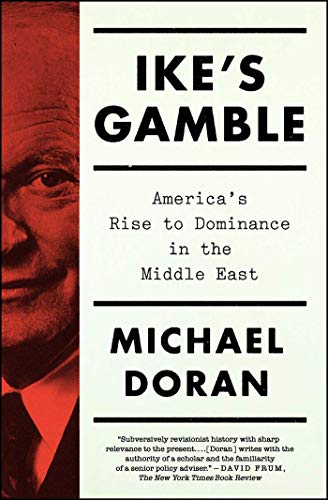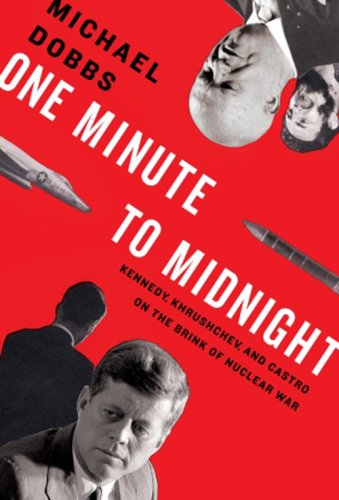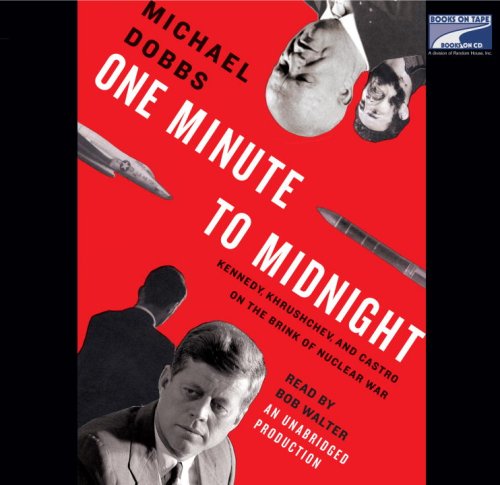-
One Minute to Midnight: Kennedy, Khrushchev, and Castro on the Brink of Nuclear War
Michael Dobbs
Paperback (Vintage, June 2, 2009)In October 1962, at the height of the Cold War, the United States and the Soviet Union came to the brink of nuclear conflict over the placement of Soviet missiles in Cuba. In this hour-by-hour chronicle of those tense days, veteran Washington Post reporter Michael Dobbs reveals just how close we came to Armageddon.Here, for the first time, are gripping accounts of Khrushchev's plan to destroy the U.S. naval base at Guantánamo; the handling of Soviet nuclear warheads on Cuba; and the extraordinary story of a U-2 spy plane that got lost over Russia at the peak of the crisis.Written like a thriller, One Minute to Midnight is an exhaustively researched account of what Arthur Schlesinger, Jr. called “the most dangerous moment in human history,” and the definitive book on the Cuban missile crisis.
-
One Minute to Midnight
Michael Dobbs
eBook (Vintage, June 3, 2008)In October 1962, at the height of the Cold War, the United States and the Soviet Union came to the brink of nuclear conflict over the placement of Soviet missiles in Cuba. In this hour-by-hour chronicle of those tense days, veteran Washington Post reporter Michael Dobbs reveals just how close we came to Armageddon.Here, for the first time, are gripping accounts of Khrushchev's plan to destroy the U.S. naval base at Guantánamo; the handling of Soviet nuclear warheads on Cuba; and the extraordinary story of a U-2 spy plane that got lost over Russia at the peak of the crisis.Written like a thriller, One Minute to Midnight is an exhaustively researched account of what Arthur Schlesinger, Jr. called “the most dangerous moment in human history,” and the definitive book on the Cuban missile crisis.
-
Down with Big Brother: The Fall of the Soviet Empire
Michael Dobbs
eBook (Vintage, March 23, 2011)"One of the great stories of our time . . . a wonderful anecdotal history of a great drama."--San Francisco Chronicle Book ReviewAs Washington Post correspondent in Moscow, Warsaw, and Yugoslavia in the final decade of the Soviet empire, Michael Dobbs had a ringside seat to the extraordinary events that led to the unraveling of the Bolshevik Revolution. From Tito's funeral to the birth of Solidarity in the Gda´nsk shipyard, from the tragedy of Tiananmen Square to Boris Yeltsin standing on a tank in the center of Moscow, Dobbs saw it all.The fall of communism was one of the great human dramas of our century, as great a drama as the original Bolshevik revolution. Dobbs met almost all of the principal actors, including Mikhail Gorbachev, Lech Walesa, Václav Havel, and Andrei Sakharov. With a sweeping command of the subject and the passion and verve of an eyewitness, he paints an unforgettable portrait of the decade in which the familiar and seemingly petrified Cold War world--the world of Checkpoint Charlie and Dr. Strangelove--vanished forever."Down with Big Brother ranks very high among the plethora of books about the fall of the Soviet Union and the death throes of Communism. It is possibly the most vividly written of the lot."-- Adam B. Ulam, Washington Post Book World
-
Down with Big Brother: The Fall of the Soviet Empire
Michael Dobbs
Paperback (Vintage, Jan. 12, 1998)"One of the great stories of our time . . . a wonderful anecdotal history of a great drama."--San Francisco Chronicle Book ReviewAs Washington Post correspondent in Moscow, Warsaw, and Yugoslavia in the final decade of the Soviet empire, Michael Dobbs had a ringside seat to the extraordinary events that led to the unraveling of the Bolshevik Revolution. From Tito's funeral to the birth of Solidarity in the Gda´nsk shipyard, from the tragedy of Tiananmen Square to Boris Yeltsin standing on a tank in the center of Moscow, Dobbs saw it all.The fall of communism was one of the great human dramas of our century, as great a drama as the original Bolshevik revolution. Dobbs met almost all of the principal actors, including Mikhail Gorbachev, Lech Walesa, Václav Havel, and Andrei Sakharov. With a sweeping command of the subject and the passion and verve of an eyewitness, he paints an unforgettable portrait of the decade in which the familiar and seemingly petrified Cold War world--the world of Checkpoint Charlie and Dr. Strangelove--vanished forever."Down with Big Brother ranks very high among the plethora of books about the fall of the Soviet Union and the death throes of Communism. It is possibly the most vividly written of the lot."-- Adam B. Ulam, Washington Post Book World
-
Down with Big Brother: The Fall of the Soviet Empire
Michael Dobbs
Hardcover (Knopf, Jan. 21, 1997)A unique account of history caught alive, Down with Big Brother recalls Dobbs' days as Washington Post Moscow bureau chief, from 1988 to 1993--during which he was eyewitness to the collapse of the Soviet Union as a world power. 528 pp. Author tour. 25,000 print.
-
One Minute to Midnight: Kennedy, Khrushchev, and Castro on the Brink of Nuclear War
Michael Dobbs
Hardcover (Alfred A. Knopf, June 3, 2008)In October 1962, at the height of the Cold War, the United States and the Soviet Union appeared to be sliding inexorably toward a nuclear conflict over the placement of missiles in Cuba. Veteran Washington Post reporter Michael Dobbs has pored over previously untapped American, Soviet, and Cuban sources to produce the most authoritative book yet on the Cuban missile crisis. In his hour-by-hour chronicle of those near-fatal days, Dobbs reveals some startling new incidents that illustrate how close we came to Armageddon.Here, for the first time, are gripping accounts of Khrushchev’s plan to destroy the U.S. naval base at Guantánamo; the accidental overflight of the Soviet Union by an American spy plane; the movement of Soviet nuclear warheads around Cuba during the tensest days of the crisis; the activities of CIA agents inside Cuba; and the crash landing of an American F-106 jet with a live nuclear weapon on board.Dobbs takes us inside the White House and the Kremlin as Kennedy and Khrushchev—rational, intelligent men separated by an ocean of ideological suspicion—agonize over the possibility of war. He shows how these two leaders recognized the terrifying realities of the nuclear age while Castro—never swayed by conventional political considerations—demonstrated the messianic ambition of a man selected by history for a unique mission. As the story unfolds, Dobbs brings us onto the decks of American ships patrolling Cuba; inside sweltering Soviet submarines and missile units as they ready their warheads; and onto the streets of Miami, where anti-Castro exiles plot the dictator’s overthrow.Based on exhaustive new research and told in breathtaking prose, here is a riveting account of history’s most dangerous hours, full of lessons for our time.
-
Ike's Gamble: America's Rise to Dominance in the Middle East
Michael Doran
eBook (Free Press, Oct. 11, 2016)“Deeply researched, tightly argued, and accessibly concise” (The New York Times Book Review)—a major retelling of the Suez Canal Crisis of 1956, a seminal event in the history of US relations with the Middle East, and why President Eisenhower sided with Egypt rather than Britain, France, and Israel, and how he came to regret that decision.In 1956 President Nasser of Egypt moved to take possession of the Suez Canal, thereby bringing the Middle East to the brink of war. The British and the French, who operated the canal, joined with Israel in a plan to retake it by force. Despite the special relationship between England and America, Dwight Eisenhower intervened to stop the invasion. In Ike’s Gamble, “a disturbing history that clearly reveals the dangerous ‘collective American delusion’ about the Middle East” (Kirkus Reviews), Michael Doran shows how Nasser manipulated the US, invoking America’s opposition to European colonialism to drive a wedge between Eisenhower and two British Prime Ministers, Winston Churchill and Anthony Eden. Meanwhile, Nasser was making weapons deals with the USSR and destabilizing other Arab countries that the US had been courting. The Suez Crisis was his crowning triumph. In time, Eisenhower would conclude that Nasser had duped him, that the Arab countries were too fractious to anchor America’s interests in the Middle East, and that the US should turn instead to Israel. “This is a story that has been told many times, but seldom with the depth and stylistic elegance of Ike’s Gamble. Michael Doran does not just challenge the prevailing historiography, he turns it on its head” (The Weekly Standard). Affording deep insight into Eisenhower and his foreign policy, this fascinating and provocative history provides a rich new understanding of how the US became the power broker in the Middle East.
-
Ike's Gamble: America's Rise to Dominance in the Middle East
Michael Doran
Hardcover (Free Press, Oct. 11, 2016)This major retelling of the Suez Crisis of 1956—one of the most important events in the history of US policy in the Middle East—shows how President Eisenhower came to realize that Israel, not Egypt, is America’s strongest regional ally.In 1956 President Nasser of Egypt moved to take possession of the Suez Canal, thereby bringing the Middle East to the brink of war. The British and the French, who operated the canal, joined with Israel in a plan to retake it by force. Despite the special relationship between England and America, Dwight Eisenhower intervened to stop the invasion. In Ike’s Gamble, Michael Doran shows how Nasser played the US, invoking America’s opposition to European colonialism to drive a wedge between Eisenhower and two British Prime Ministers, Winston Churchill and Anthony Eden. Meanwhile, in his quest to make himself the strongman of the Arab world, Nasser was making weapons deals with the USSR and destabilizing other Arab countries that the US had been courting. The Suez Crisis was his crowning triumph. In time, Eisenhower would conclude that Nasser had duped him, that the Arab countries were too fractious to anchor America’s interests in the Middle East, and that the US should turn instead to Israel. Affording deep insight into Eisenhower and his foreign policy, this fascinating and provocative history provides a rich new understanding of how the US became the power broker in the Middle East.
-
One Minute to Midnight: Kennedy, Khrushchev, and Castro on the Brink of Nuclear War
Michael Dobbs
Hardcover (Knopf, June 3, 2008)In October 1962, at the height of the Cold War, the United States and the Soviet Union appeared to be sliding inexorably toward a nuclear conflict over the placement of missiles in Cuba. Veteran Washington Post reporter Michael Dobbs has pored over previously untapped American, Soviet, and Cuban sources to produce the most authoritative book yet on the Cuban missile crisis. In his hour-by-hour chronicle of those near-fatal days, Dobbs reveals some startling new incidents that illustrate how close we came to Armageddon.Here, for the first time, are gripping accounts of Khrushchev’s plan to destroy the U.S. naval base at Guantánamo; the accidental overflight of the Soviet Union by an American spy plane; the movement of Soviet nuclear warheads around Cuba during the tensest days of the crisis; the activities of CIA agents inside Cuba; and the crash landing of an American F-106 jet with a live nuclear weapon on board.Dobbs takes us inside the White House and the Kremlin as Kennedy and Khrushchev—rational, intelligent men separated by an ocean of ideological suspicion—agonize over the possibility of war. He shows how these two leaders recognized the terrifying realities of the nuclear age while Castro—never swayed by conventional political considerations—demonstrated the messianic ambition of a man selected by history for a unique mission. As the story unfolds, Dobbs brings us onto the decks of American ships patrolling Cuba; inside sweltering Soviet submarines and missile units as they ready their warheads; and onto the streets of Miami, where anti-Castro exiles plot the dictator’s overthrow.Based on exhaustive new research and told in breathtaking prose, here is a riveting account of history’s most dangerous hours, full of lessons for our time.
-
One Minute to Midnight: Kennedy, Khrushchev, and Castro on the Brink of Nuclear War
Michael Dobbs
Audio CD (Books on Tape, March 15, 2008)October 1963. The height of the Cold War and the U.S. and USSR slide toward a nuclear conflict over missiles in Cuba. Washingto Post reporter Michael Dobbs pored over untapped sources to write the most authoritative book yet on the Cuban missle crisis.
-
One Minute to Midnight
Michael Dobbs
Paperback (Arrow Books, March 1, 2009)October 27, 1962, a day dubbed Black Saturday in the Kennedy White House. The Cuban missile crisis is at its height, and the world is drawing ever closer to nuclear apocalypse. As the opposing Cold War leaders, John F. Kennedy and Nikita Khrushchev, mobilize their forces to fight a nuclear war on land, sea and air, the world watches in terror. In Bobby Kennedy's words, 'There was a feeling that the noose was tightening on all of us, on Americans, on mankind, and that the bridges to escape were crumbling'.In "One Minute to Midnight" Michael Dobbs brings a fresh perspective to this crucial moment in twentieth-century history. Using a wealth of untapped archival material, he tells both the human and the political story of Black Saturday, taking the reader into the White House, the Kremlin and along the entire Cold War battlefront. Dobbs' thrilling narrative features a cast of characters - including Soviet veterans never before interviewed by a western writer - with unique stories to tell, witnesses to one of the greatest mobilizations of men and equipment since the Second World War.
-
Ike's Gamble: America's Rise to Dominance in the Middle East
Michael Doran
Paperback (Free Press, Oct. 24, 2017)“Deeply researched, tightly argued, and accessibly concise” (The New York Times Book Review)—a major retelling of the Suez Canal Crisis of 1956, a seminal event in the history of US relations with the Middle East, and why President Eisenhower sided with Egypt rather than Britain, France, and Israel, and how he came to regret that decision.In 1956 President Nasser of Egypt moved to take possession of the Suez Canal, thereby bringing the Middle East to the brink of war. The British and the French, who operated the canal, joined with Israel in a plan to retake it by force. Despite the special relationship between England and America, Dwight Eisenhower intervened to stop the invasion. In Ike’s Gamble, “a disturbing history that clearly reveals the dangerous ‘collective American delusion’ about the Middle East” (Kirkus Reviews), Michael Doran shows how Nasser manipulated the US, invoking America’s opposition to European colonialism to drive a wedge between Eisenhower and two British Prime Ministers, Winston Churchill and Anthony Eden. Meanwhile, Nasser was making weapons deals with the USSR and destabilizing other Arab countries that the US had been courting. The Suez Crisis was his crowning triumph. In time, Eisenhower would conclude that Nasser had duped him, that the Arab countries were too fractious to anchor America’s interests in the Middle East, and that the US should turn instead to Israel. “This is a story that has been told many times, but seldom with the depth and stylistic elegance of Ike’s Gamble. Michael Doran does not just challenge the prevailing historiography, he turns it on its head” (The Weekly Standard). Affording deep insight into Eisenhower and his foreign policy, this fascinating and provocative history provides a rich new understanding of how the US became the power broker in the Middle East.